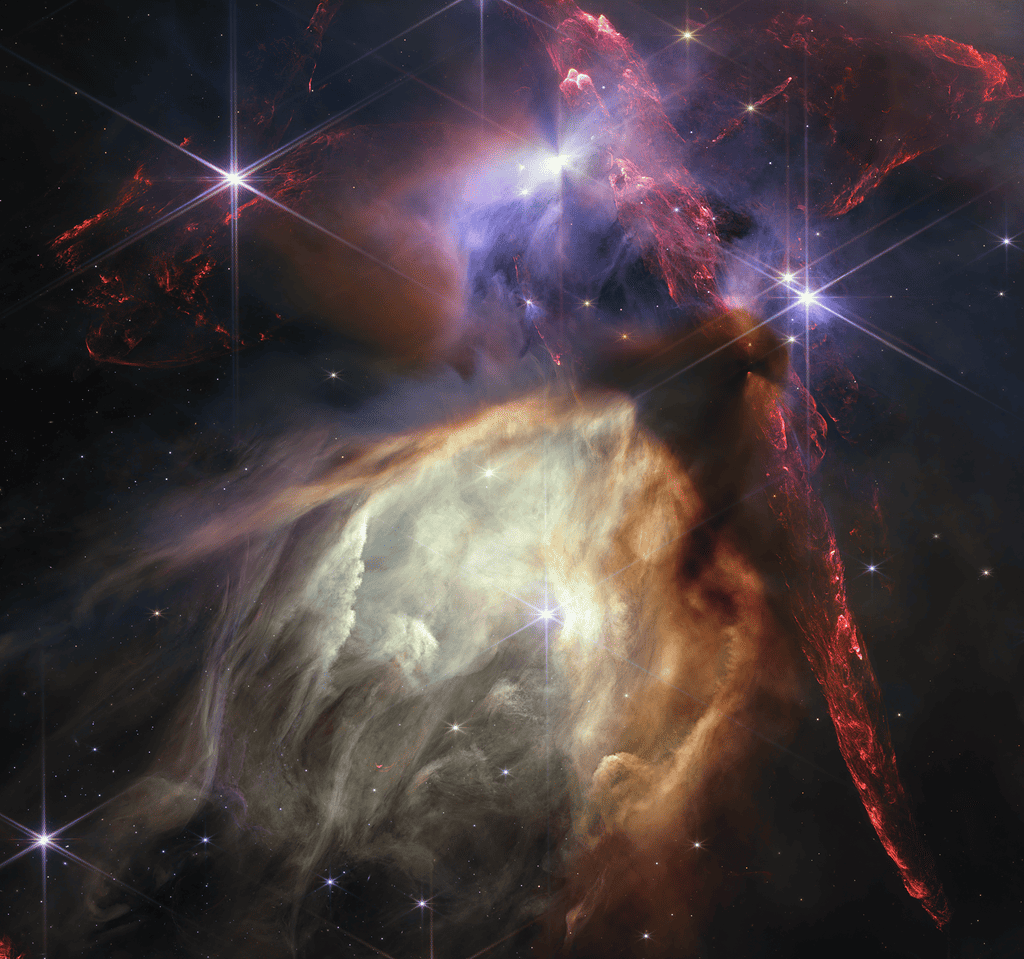Exactly one year ago, the James Webb Space Telescope (JWST) went live with a bang, releasing an astonishing image of thousands of galaxies and other features. Now, to celebrate one year, the JWST team has released a new image and it’s almost too much to handle.

“Amazingly, it’s been a year since we had the unveiling of the first early release science observations which included both the imaging and the spectra,” said Chris Evans, ESA Hubble & Webb Project Scientist.
“It’s amazing to be here now sharing the anniversary image and this amazing surge of results,” Evans added, at a briefing on JWST at the European Astronomical Society (EAS) in Krakow, Poland.
The image depicts a relatively small and quiet stellar nursery — the Rho Ophiuchi cloud complex, the closest star-forming region to Earth. But looking at the image alone, it seems anything but quiet. With jets bursting from stars, interstellar gas, and molecular hydrogen, the image seems to be bursting with stellar “life”.
A year of Webb
The image was taken using five of the Near Infrared Camera (NIRCam) filters, so it brings together five different wavelengths. In particular, the wavelengths that JWST excels in are very well-suited to study this type of region.
Unlike its predecessor Hubble, which studied the universe primarily in optical and ultraviolet wavelengths, JWST focuses more on the infrared. Infrared light, along with JWST’s massive mirror, reveals new details in images, deepening our understanding of celestial objects.
“If you look in the visible wavelength, this is really unexciting,” says Evans. “But when you look at it in the near-infrared, this is what you see and it’s just spectacular.
For researchers like Tom Ray, Co-Principal Investigator of the Mid-Infrared Instrument on the JWST, this type of capability is extremely exciting. Ray is looking at how stars and planets form. At the same EAS briefing, he explained that planets form very quickly around stars — at least in astronomic terms. A planet can form within one million years, which sounds like a lot, but compared to the age of our Sun, which is around 5,000 million years old, it’s the blink of an eye.
Astronomers have long tried to look at star-forming areas to better understand these mechanisms, but the problem is that these regions were very difficult to image before the JWST.
“The JWST can provide us infrared radiation and in particular it’s got very high resolution and fine details. So we can penetrate through the dust and make up what conditions were like when the Earth formed,” Ray explained.
This is why areas like Rho Ophiuchi are so exciting, and this is what makes the JWST so special. Sure, this is an amazing image. Yes, you can print this and put it on your wall (please do!). But you can actually do a lot of science by imaging this type of area.
“Every new image is a new discovery, empowering scientists around the globe to ask and answer questions they once could never dream of,” said NASA Administrator Bill Nelson in a release.
Some stars in this image, for instance, display the telltale shadow of a circumstellar disc, the makings of future planetary systems. The massive supersonic jets that stretch for several light years are also there — and these jets are not thought to be closely lined with planet formation, says Ray. The molecular hydrogen is traced in red and tens of stars are visible in the image, including one larger star at the center of the yellow cavity.
This type of image is just a highlight of what the JWST has done, and it’s only been in space for a year. In addition to helping astronomers understand how stars and planets are formed, it can also help us look at some of the farthest parts of our universe. Looking at things that are so far away is like looking back in time, and if you look far enough, you can see signs of the early days of the universe. Of course, the JWST can also image exoplanets and even planets in our solar system.
As the JWST starts its second year of work, it is clear that we’re only starting to glimpse its revolutionary capabilities. With the capacity to probe deeper into space than ever before, astronomers are eager to find vital clues about the birth of stars, the formation of galaxies, and the early days of our universe. The image of Rho Ophiuchi is not just a beautiful to look at — it’s a testament to human curiosity, technological achievement, and the quest for knowledge that drives us to look beyond our own planet and reach for the stars.
Here’s the full image description, per the European Space Agency (ESA):
Red dual opposing jets coming from young stars fill the darker top half of the image, while a glowing pale-yellow, cave-like structure is bottom centre, tilted toward two o’clock, with a bright star at its centre. The dust of the cave structure becomes wispy toward eight o’clock. Above the arched top of the dust cave three groupings of stars with diffraction spikes are arranged. A dark cloud sits at the top of the arch of the glowing dust cave, with one streamer curling down the right-hand side. The dark shadow of the cloud appears pinched in the centre, with light emerging in a triangle shape above and below the pinch, revealing the presence of a star inside the dark cloud. The image’s largest jets of red material emanate from within this dark cloud, thick and displaying structure like the rough face of a cliff, glowing brighter at the edges. At the top centre of the image, a star displays another, larger pinched dark shadow, this time vertically. To the left of this star is a more wispy, indistinct region.


